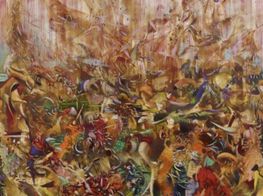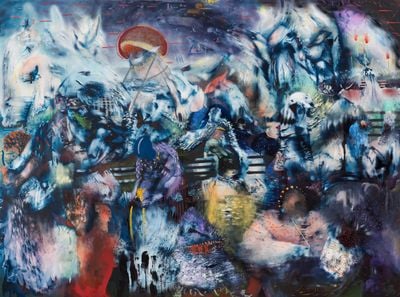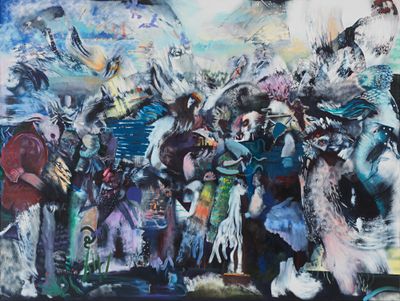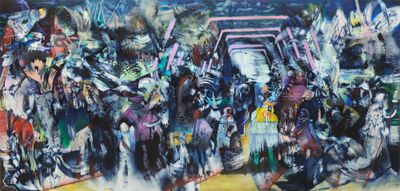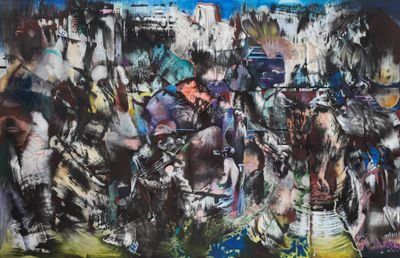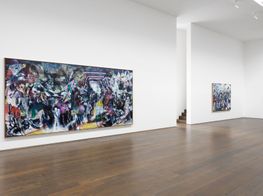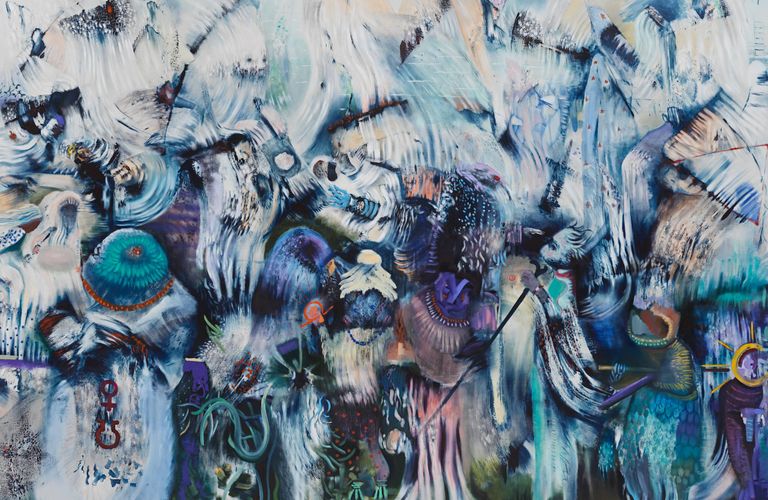
Ali Banisadr Orchestrates the Senses at Victoria Miro
Synaesthesia is a condition as fascinating as it is rare. Present in under five percent of the population, those affected see their senses blend—a colour could be heard, while a word could trigger a specific taste.
For Iranian-born, New York-based artist Ali Banisadr, this sensation was first experienced during childhood, as he took up drawing as a way to make sense of the sound of explosions and destruction when growing up in war-torn Tehran during the 1970s.
Treating each painting as an orchestra, and each composition a stage, Banisadr has found an outlet for such sensations, painting cathartic explosions of memory, woven with references to his studies into art history.
On the occasion of his debut solo exhibition The Changing Past with Victoria Miro in London (11 October–11 November 2023), Ocula Advisory sits down with Banisadr to discuss his upbringing in Tehran, his experience of synaesthesia, and the conversations that shaped his art education.
You were born in Tehran in 1976 and grew up there throughout the Iranian Revolution and the Iran-Iraq War. What is your first memory of putting pen to paper when a child? Or rather was it an experience of viewing art itself?
My entire childhood was spent in political upheaval, therefore I used drawing as a way to try to understand this abstract chaotic world around me. This was the first attempt to use visual language to interpret the world, which was partly in ruins and very fragmented. Visual language was more satisfying in order to try to understand something so abstract.
But then when I was around seven we took a European trip with my family. One stop was the Sistine Chapel. Michelangelo's Last Judgment (1535–1541) gave me an out-of-body experience that is still with me today. This experience made me understand what art is capable of doing and I try to recreate that experience to this day.
After moving to California with your family aged 12, you moved to New York to go to art school. Around this time you've spoken about how you hung with graffiti artists, chatting about art history, and how those conversations shaped your art education. Could you expand?
San Francisco in the mid 1990s was like New York in the 1980s, it was the golden year of graffiti art and in my opinion also the golden year of hip-hop. It was a very exciting time to live there. My group of friends were all graffiti artists, although our conversation was not limited to this. We also discussed art history and were in tune with contemporary art as well but none of us were going to art school yet.
I think this sense of community at the time and the discussions before attending art school were very raw and useful for me to this day. To not get caught up and always have a rebellious attitude towards the trends. Graffiti art to me was about anti-establishment, going against the grain and being a social critic.
You've spoken about your experience of synaesthesia during your childhood where you would draw 'to create a visual understanding of the sounds I was hearing—the vibrations, explosions, and air raids'. Can you remember the first time you experienced this?
Memory can be a tricky thing because it is a combination of fragments that are always changing. I am very much interested in how memory works and how it changes over time. By this I mean personal memory as well as our collective memory. Hence the title of my show The Changing Past.
My memory of my childhood and the sounds of war are mostly auditory, but some are also visual which I can remember very clearly. When a bomb was dropped in the playground of my school, it left a massive crater in the middle of the playground and this image has worked its way in a variety of forms into my paintings. It makes you understand the dark side of humanity.
I read somewhere that before you apply your first stroke, you sit and look at the white canvas for hours, sometimes days, before you put paint to canvas. What's running through your mind in these drawn-out moments?
I try to get a sense of the space, the composition, the mood, and how I am going to perform since the beginning requires a sort of performance action painting. It takes time to know what will emerge and present itself, what symbols and images want to become visible. I have to tune in and receive to make the invisible, visible.
Movement on your canvas is gestural, yet controlled. It brings to mind a conductor gesticulating to their orchestra, or the commotion of a flock of birds flapping their wings before they take flight. How do you achieve these competing sensibilities?
Every time I finish a painting I ask myself the same question. I don't know how I did it!
When you are in the moment of painting, on the best days when the best decisions are made and the painting moves along quite a bit, you sort of lose yourself within time and place and there is a sense of the disappearing of the self that must happen for the painting to miraculously come together. In a way you have to lose yourself for the painting to show you who you are!
Do you ever listen to music while painting? Or does this interrupt the flow?
I do listen to music, audiobooks, and podcasts. But these are always in the background, they are very different sounds than the sound I hear from the painting itself. If I feel that the music is interrupting then I paint in silence.
How did sound guide the outcome of this exhibition?
Each painting is an orchestra and its own world, sort of like an opera and I see the composition as a stage. Within each painting, there are many notes of sounds. As the eyes move around the painting you can activate different notes, but the challenge is always to unite them.
In the largest painting in the show, These fragments I have shored against my ruins (2023), there is a portal which has an architectural element to it, and this portal to me has the sound of the digital world, maybe a sound of AI, interrupting the painting.
It has a vibration of light; a Dan Flavin sort of light. Sound is ultimately the guiding force in the way I construct paintings. As the eyes move throughout the painting, there are different notes of sounds that are part of the bigger orchestra.
You now live and work in New York. What does a day look like for you in the studio?
I have always liked having a live/work situation because every day varies in some way and I don't see the separation between the two. But some things are always consistent: I have breakfast with my family, and then take my two daughters to school. When I come back, I am in the studio all day. In the studio, I am reading, drawing, sculpting, painting, and contemplating.
The key is to show up every day and move things along. Research is a huge part of my practice and it is what fuels my work, so there are a lot of rabbit holes open at all times which can take a lifetime of learning and researching.
Main image: Ali Banisadr, Queen of the Night (2022). Oil on linen. 208.3 x 304.8 cm. Courtesy the artist and Victoria Miro. © Ali Banisadr.

